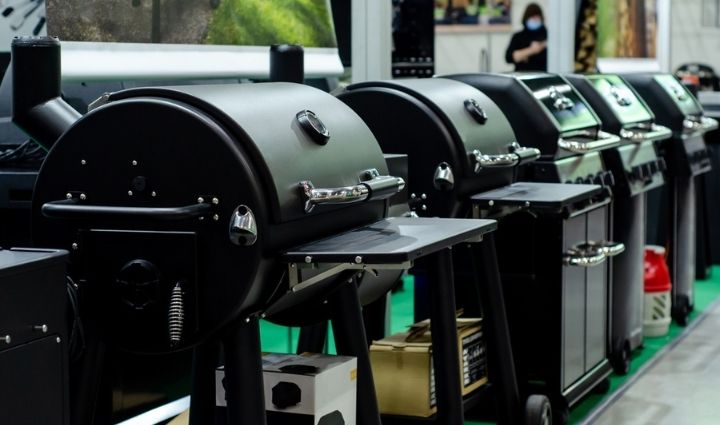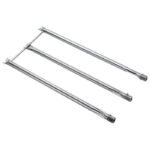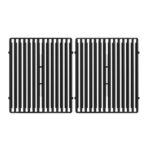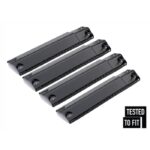Gas and charcoal grills are the two most common types of outdoor grills, but that doesn’t mean your choices are limited to these BBQ mainstays. There are several types of outdoor barbecue grills on the market, ranging from high-tech gas barbecue grills to simple grilling options like disposable barbecue grills.
The best option ultimately depends on your cooking preferences, how much space you have available, and what budget you’re working with. Whether you’re a BBQ novice or a seasoned griller, it helps to understand all the different types of outdoor barbecue grills that are available to you before you make a purchase.
In this guide, we’ll take a closer look at ten types of outdoor barbecue grills, including different types of gas grills, types of charcoal grills, their features, price ranges, advantages and disadvantages, and who they are most suitable for.
Keep reading to learn more about:
- Propane barbecue grills
- Natural gas grills
- Built-in gas barbecue grills
- Charcoal kettle barbecue grills
- Kamado style cookers
- 55-gallon steel drum barbecue grills
- Pellet grills
- Portable barbecue grills
- Hibachi-style tabletop barbecue grills
- Disposable instant/ready-to-use barbecue grills
Types of Gas Grills
Gas grills offer superior speed and convenience and are typically the easiest to maintain. Here are four of the most common types of gas grill:
1. Propane barbecue grills
Propane barbecue grills are one of the most popular types of outdoor grills. They’re easy to use, they heat up quickly, and they offer greater control over the temperature than other types of grills. They’re available in a number of sizes with varying arrays of features to suit your budget, and they’re also easy to maintain with regular cleaning. Parts are typically easy to replace as well.
Propane gas doesn’t add any flavor so that classic smoky BBQ flavor is created when the meat’s fat sizzles onto the heat plates or the stones (depending on the grill’s model) that sit above the burner. Grilling enthusiasts might not recommend gas grills since they don’t create the same level of smoky flavor as charcoal. However, it’s easy to add an extra dose of wood smoke flavor by simply filling a smoker box with wood chips and placing it on the cooking grates of a hot gas grill.
Don’t forget to grab a barbecue grill cover with your new gas barbecue grill to protect it against the harsh natural elements.
Suitable for: Home chefs who want a grill that is quick and easy to start, grill on, and maintain.
Price: Ranges from $100 to $3,500+
Advantages
- Quick and easy to start—no need to prepare charcoal
- Easy to maintain
- Offers enough grilling space for a crowd
- Can be used anywhere as long as you have a propane tank
Disadvantages
- The food’s flavor may not taste as smoky as charcoal
- Can be expensive compared to some other options
- Large sizes require more space
- Can run out of fuel while cooking if the tank level is not closely monitored
- Propane tanks have to be refilled from time to time
2. Natural gas grills
Gas barbecue grills can also be powered by natural gas. If your house has a natural gas line, a natural gas model may be more convenient and more economical than using refillable propane tanks.
Natural gas grills offer the same advantages as propane grills—they’re easy to light, easy to maintain, and offer greater control over temperature. Like propane grills, they also lack that classic smoky flavor, but it’s easy to create it with the help of a smoker box.
Suitable for: Backyard grillers with a natural gas line who want a grill that is quick and easy to start, grill on, and maintain.
Price: Ranges from $300 to $3,500+
Advantages
- Quick and easy to start—no need to prepare charcoal
- Easy to maintain
- Never run out of fuel
- Offers enough grilling space for a crowd
Disadvantages
- The food’s flavor may not taste as smoky as charcoal
- Can be expensive compared to some other options
- Large sizes require more space
- Have to be in proximity to a natural gas line
3. Built-in gas barbecue grills
Built-in gas grills are gas grills that are built into an outdoor kitchen. Like gas grills, they are available in propane or natural gas options.
If you have a big backyard with a nice deck and a poolside structure, a built-in gas barbecue grill can take your outdoor kitchen to the next level. These grills are a permanent and elegant option that allows you to customize the outdoor kitchen space to your liking.
Suitable for: Chefs who have a big backyard and the space to integrate an outdoor kitchen solution to entertain guests.
Price: Ranges from $1,000 to $10,000+. Professional models can reach up to $30,000.
Advantages
- An elegant outdoor solution that offers a large amount of space for home chefs
- Quick and easy to start—no need to prepare charcoal
- Offers enough grilling space for a crowd
Disadvantages
- Costly to install and setup
- Requires dedicated backyard space since they need to be permanently built-in
- Not portable / fixed location
4. Portable barbecue grills (also known as table barbecue grills)
Portable barbecue grills run on small-sized propane tanks or electricity. Because of their portability and convenience, these grills are often used for picnics at the park, camping, or in smaller spaces like a high-rise condo.
If you are considering buying a portable barbecue grill, pick a model that is lightweight and durable—especially if you plan to take it camping, tailgating, or to a picnic. If you are consistently using your portable grill in the same location, we recommend purchasing a propane adaptor hose that enables you to connect to a 20 lb propane tank rather than the standard 1 lb tanks that most portable gas grills use.
Suitable for: Tailgaters, campers or hikers, and those who love to grill at outdoor picnics. Portable electric grills are particularly great for people who live in apartments or condos where fire regulations prohibit the use of gas or charcoal grills.
Price: Ranges from $50 to $400+
Advantages
- Portable
- Compact and easy to store
- Good for small spaces
Disadvantages
- Small cooking space, so they’re not suitable for throwing barbecue parties or entertaining a huge crowd
- No smoky flavor
- Uses 1 lb propane tanks with short run time
Types of Charcoal Grills
Charcoal grills are best for creating that classic BBQ flavor, but they require a little extra prep to light and clean, and it can be tougher to maintain the right temperature. Let’s take a look at 5 common types of charcoal grill:
5. Charcoal kettle barbecue grills
Charcoal kettle barbecue grills use charcoal briquettes as fuel and are one of the most basic types of grills. They’re a favorite among grilling enthusiasts because they are economical and versatile, and they are often praised for their ability to produce tastier and juicier red meat than a gas grill.
Charcoal kettle grills also grill at a higher temperature than gas grills, which makes searing much easier. However, charcoal takes almost 45 minutes to heat up, so these grills can be very time-consuming to start up if all you want to do is prepare a quick meal.
Suitable for: Chefs who like smoky and flavorful meat and don’t mind the hassle of lighting up charcoal.
Price: Ranges from $40 to $500+. Higher-end models can reach up to $2,000.
Advantages
- Charcoal gets hotter than gas
- Versatility for different grilling methods
- Yields food with excellent flavor
- More affordable than gas grills
Disadvantages
- Time-consuming to set up—it can take 45 minutes to get the coals to heat up
- Cleaning up charcoal can be a chore
- While the grill itself isn’t expensive, buying the charcoal can get expensive over time compared to gas grills
6. Kamado style cookers
Kamado-style cookers are shaped like a dome or egg and use lump charcoal to create heat. They’re among the most versatile types of charcoal grill and can be used to smoke, roast, and even bake. The most popular type of Kamado style cooker is the Big Green Egg.
Based on early clay ovens that first appeared in China 3,000 years ago, today’s Kamado cookers are made of ceramic or other types of insulating material to hold in heat and moisture. This means they are excellent for retaining heat and maintaining an even temperature, but they can take a long time to warm up and it may be difficult to cool them down if you overheat them.
Suitable for: Serious chefs who want the versatility to grill or to smoke their meat.
Price: Ranges from $300 to $3,000+
Advantages
- Great for smoking since they are made with ceramic or another type of insulating material—the temperature is always consistent
- Very durable
- Versatile—can be used as a regular grill or as a smoker
- Excellent for long, slow cooking
- Yields food with excellent flavor
Disadvantages
- Higher-end models can be expensive
- Can take time to preheat and are slow to cool down
- Very heavy because of the thick ceramic walls
- There is a definite learning curve to mastering this style of grill
7. Pellet grills
Pellet grills are a newer type of outdoor grill that is steadily gaining in popularity. Also known as pellet smokers, pellet grills use food-grade wood that has been compressed into a pellet as a fuel source.
Think of pellet grills like a mashup between gas and charcoal grills—these grills use an electric starter and control panel to manage temperature but generate heat and smoke through wood fire to cook and flavor food. Pellets are placed in a chamber called a pellet hopper, then they move through an auger to a fire pot to heat the cooking chamber. Heat and smoke are distributed through the grill using a fan system.
Pellet grills heat relatively quickly—faster than a charcoal grill, but slower than a gas grill. They can be used for direct grilling, smoking, or even like an outdoor oven.
Suitable for: Those who want versatility and don’t plan to use their grill to sear meat.
Price: Ranges from $250 to $2,000+
Advantages
- Heat quickly
- Smoky flavor
- Very versatile—can be used to grill, smoke, bake, and braise food
- Easier to maintain precise temperature
Disadvantages
- Can be expensive
- Require more regular maintenance
- Requires ongoing purchase of pellets
- Electric, electronic, and mechanical parts can fail over time and require replacement
8. 55-gallon steel drum barbecue grills
If you can scavenge a 55-gallon drum, you can turn it into a barbecue grill for very little cost—all you need to buy is the rest of the material. These DIY grills are a very economical option for those who are handy and want to make their own barbecue or those who want a larger version of a classic kettle charcoal grill.
55-gallon steel drum barbecue grills can be used as a barbecue or as a smoker. Due to their large size, they can accommodate much larger meat cuts and at larger quantities. They are especially popular for southern-style barbecue and those who participate in competition barbecue grilling.
To learn how to build your own 55-Gallon steel drum barbecue grill, follow these instructions for How to Build Your Own Barrel.
Suitable for: Those who want a larger variation of the kettle grill or competition grillers.
Price: Ranges from $0 to $250 depending on the material you scavenge or purchase to build one.
Advantages
- Charcoal gets hotter than gas
- Versatility for different grilling methods
- Very large grilling space, allows you to cook larger meat cuts
- Offers enough grilling space for a crowd
Disadvantages
- Time-consuming to build
- Time-consuming to set up—it can take 45 minutes to get the coals to heat up
- Cleaning up charcoal can be a chore
While the grill itself isn’t expensive, buying the charcoal can get expensive over time compared to gas grills
9. Hibachi-style tabletop barbecue grills
Hibachis (meaning “fire bowl” in Japanese) are small and portable grills that feature a cooking grate that sits on top of a pan that holds charcoal. You can adjust the cooking temperature simply by raising or lowering the cooking grate.
Since the charcoal sits very close to the cooking grate, this type of grill can sear meat quicker than the other types of grills. Hibachis work well for grilling beef teriyaki, skewers, sates, and other thinly sliced or small cuts of meat. However, because Hibachi grills don’t have a lid, you’ll need a different type of grill if you ever plan on grilling your meat over indirect heat.
Suitable for: Chefs who are on a budget and want to have a charcoal grill experience but don’t have the space or the budget for a full-sized charcoal kettle grill.
Price: Ranges from $15 to $75
Advantages
- Portable size—great for those with limited space
- Compact and easy to store
- Fuel-efficient
- Inexpensive grill
Disadvantages
- Cannot be used for indirect grilling since it doesn’t have a lid
- Difficult to achieve even heat since they’re typically cheaply made with thin metals and the heat source is exposed to the wind without a lid
- Small cooking space so they’re not suitable for throwing barbecue parties or entertaining a huge crowd
10. Disposable instant / ready-to-use barbecue grills
Disposable barbecue grills are a convenient option for anyone who grills occasionally, such as at picnics or camping. These grills are single-use, but they’re a great option if you have limited storage space for a permanent grill (for example, if you live in a condo). Disposable barbecue grills come with everything you need to start grilling, including a foil pan with the charcoal and cooking grate. Just bring a lighter to fire it up!
Suitable for: Those who love to grill at outdoor picnics, camping, or living in condos.
Price: Ranges from $5 to $15
Advantages
- Portable and compact
- Convenient and quick to clean up
- Inexpensive
Disadvantages
- Single-use only
- Can only cook for about an hour
- Cannot be used for indirect grilling since it doesn’t have a lid
- Difficult to achieve even heat since they’re exposed to the wind without a lid
- Can be flimsy
- Not environmentally friendly
Final Thoughts
Gas grills offer convenience and ease, while charcoal grills offer that classic smoky BBQ flavor. Understanding the different types of outdoor grills can help you determine which type of gas or charcoal grill works best for your lifestyle, budget, and your cooking needs.





